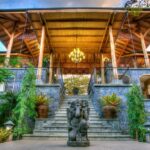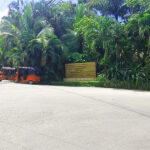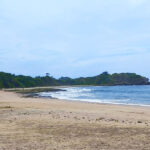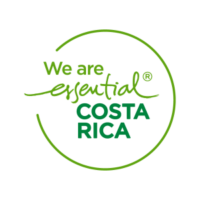Service 24/7/365
info@gypsycabnosara.com
Phone: + (506) 8302-1903
info@gypsycabnosara.com
- About
- Contact
- Publications
- LIR Airport – Nosara
- SJO Airport – Nosara
- Other Services
- My account
- Cart
- About
- Contact
- Publications
- LIR Airport – Nosara
- SJO Airport – Nosara
- Other Services
- My account
- Cart
10 Articles You Can Read on National Geographic About Costa Rica

Introduction
Costa Rica, a small country nestled in Central America, is a treasure trove of biodiversity, rich culture, and sustainable practices. National Geographic has published numerous articles that provide a deep dive into the country’s unique aspects. Here are ten articles that offer a glimpse into the vibrant world of Costa Rica.
Costa Rica: A Walk on the Wild Side
In the heart of Costa Rica’s Osa Peninsula, life thrives at a unique rhythm, harmonizing with the melodies of the jungle. As dawn breaks, the day commences with the symphony of nature, from the resonating calls of howler monkeys to the vibrant hues of a chestnut-mandible toucan perched on a kapok tree. The Osa Peninsula, nestled on Costa Rica’s Pacific Coast near the Panamanian border, is a treasure trove of biodiversity, boasting an impressive 2.5% of the world’s species within an area half the size of Kent. This rich ecosystem is largely safeguarded by the Corcovado National Park, a renowned sanctuary that, while beneficial to Costa Rica’s economy, has inadvertently overlooked the surrounding rural communities.
To address this, the Caminos de Osa, a community tourism initiative launched in 2015, seeks to distribute wealth more equitably. The three trails of the Caminos de Osa offer visitors not only the opportunity to witness the same incredible wildlife as in Corcovado but also to immerse themselves in traditional culture and contribute to the preservation of local nature. The Camino del Oro, or Trail of Gold, for instance, takes you on a seven-mile hike to Rancho Quemado, a quaint community of farmers and artisans. Here, amidst the fluttering blue morpho butterflies and the mysterious ‘path of felines’, one can truly appreciate the golden essence of Costa Rica’s wild side.
Costa Rica: Riding the Rapids
Navigating the fast-flowing Sarapiqui River in Costa Rica is an adventure that demands teamwork and resilience. As you paddle through the white water in an inflatable raft, the sight of black vultures perched on the river rocks and circling overhead adds a thrilling edge to the journey. Guided by the stern voice of the raft leader, you and your team must work in unison to safely traverse the eight-mile stretch of the river. The experience is intensified by the river’s fluctuating water levels, which can halve the journey time during the rainy season in November.
The Sarapiqui River journey is not just about the adrenaline rush; it’s also a gateway to the vibrant wildlife and lush foliage of the Costa Rican jungle. Amid the splashing and fizzing of the river, you can hear the symphony of chirping insects and birdsong, and even the occasional howler monkey’s call. The river is home to a variety of birds, including the green kingfisher and blue heron, and the surrounding vegetation tells stories of local culture, such as the Indian cane once used for roofing homes. The journey is punctuated by thrilling moments of bouncing past boulders, navigating cascades of rapids, and even the occasional unexpected dip in the river. But with the warmth of the water and the exhilaration of the ride, it’s an adventure you’re determined to complete aboard the raft.
Regenerative Tourism in Costa Rica
In the heart of Costa Rica, on the edge of La Amistad International Park, lies Selva Bananito Ecolodge, a beacon of regenerative tourism. This eco-friendly haven is the brainchild of Jurgen Stein, a man who has dedicated his life to environmental conservation. Despite the country’s reputation as a green utopia, Stein is quick to point out that the reality is more complex, with half of the country’s forested land in private hands. Selva Bananito, however, is a testament to Stein’s commitment to sustainability. With no significant power in the cabins and a ban on plastic bottles, the lodge’s carbon output is reportedly less than that of the average US citizen.
Selva Bananito’s approach to tourism is as rustic as it is regenerative. The lodge offers a range of activities, from horse rides to jungle treks, and even lectures on environmentalism. Stein’s dedication to ecotourism has not been without challenges, including threats from those who wish to exploit his land. However, he remains undeterred, viewing these challenges as a sign that he’s on the right track. The lodge’s commitment to sustainability extends to its water supply, which is filtered with activated carbon, and its efforts to keep the local rivers clean. Despite the occasional controversy, such as Stein’s petrol-fuelled gyrocopter flights for guests, the lodge stands as a testament to the potential of regenerative tourism in Costa Rica.
Forging New Culinary Traditions in San Jose, Costa Rica
In the bustling capital of Costa Rica, San José, a culinary revolution is underway. A group of innovative chefs is redefining Costa Rican cuisine, moving beyond the traditional rice and beans to create a new gastronomic identity. Santiago Fernández Benedetto, the chef behind the restaurant Silvestre, is one such culinary pioneer. He is known for his creative twists on traditional dishes, aiming to evoke nostalgia and emotional connections through food. His unique approach to Costa Rican cuisine has been so groundbreaking that it has even led to tears at the dining table.
This culinary renaissance is not just about reinventing traditional dishes, but also about rediscovering and celebrating the country’s indigenous culinary heritage. Pablo Bonilla, the chef at Sikwa, is leading this charge. He spends weeks at a time with indigenous tribes, learning their cooking techniques and recipes, and incorporating them into his restaurant’s menu. Meanwhile, Marco Leiva, the chef-owner of Furca, is striving for self-sufficiency, working with local producers to create unique Costa Rican versions of international ingredients. These chefs are not just changing the way Costa Rican food is perceived, but also redefining what it means to be a gastronomic destination.
How Farm-to-Fork is a Way of Life in Costa Rica
In Costa Rica, the farm-to-fork concept is not just a trendy catchphrase but a way of life deeply ingrained in the country’s culinary culture. The nation’s fertile volcanic soils, diverse topography, and rich biodiversity make it a veritable cornucopia of fresh produce, from bananas and pineapples to sugar, rice, and peanuts. Chefs like Jose González and Marco Leiva are champions of this hyper-local approach, incorporating indigenous produce into their menus and even operating their own farms. However, the name that stands out in this movement is Randy Siles, the chef at Shambala restaurant in Santa Teresa, who is known for his ‘zero kilometer philosophy’.
Siles is dedicated to using Costa Rican-grown produce wherever possible, often turning to underused or obscure ingredients to create his culinary masterpieces. He works closely with local artisans, including beekeepers, fishermen, and farmers, to source his ingredients. His dishes, such as the local variant of tacos, gallo de picadillo, or the super-fresh chucheca de Lepanto (a mollusk) with passion fruit foam, are a testament to his commitment to sustainability and local sourcing. But Siles’ vision extends beyond the kitchen. His restaurant doubles as a social enterprise, training disenfranchised young people in the trade and equipping them with essential skills for a better future. This initiative has already seen more than 90 students pass through the program, laying the groundwork for the next generation of farm-to-fork advocates in Costa Rica.
Why Costa Rica Should Be a Blueprint for Conservation
Costa Rica, a country renowned for its pristine rainforests and abundant wildlife, serves as a beacon of hope for conservationists worldwide. TV presenter and wildlife gardener Kate Bradbury shares her experiences of exploring the country’s diverse ecosystems, from the rainforests of the Osa Peninsula to the cloud forests in the north. She marvels at the unique wildlife, including rainbow-colored birds, elusive sloths, and howler monkeys, and the distinct flora, such as trees consumed by parasitic vines and curtains of moss and epiphytes.
What sets Costa Rica apart, however, is its commitment to sustainability and biodiversity. The country is working towards becoming carbon neutral by 2050 and has doubled its forested areas over the past 30 years, despite previous deforestation. This dedication to the natural world, Bradbury believes, should serve as a blueprint for other nations. She envisions a future where more countries invest in their natural environments, creating habitats for wildlife and compensating for the degradation of rural landscapes. Costa Rica’s example, she asserts, teaches us that it is possible to balance urban development with nature conservation, offering a hopeful vision for the future of our planet.
Costa Rica: In Search of the Quetzal
Deep within the Monteverde Cloud Forest of Costa Rica, a quest unfolds to spot the elusive quetzal, a bird renowned for its iridescent plumage. This journey embarked upon at the break of dawn, takes you through a lush landscape teeming with life, from chirping insects and whistling birds to unseen creatures rustling in the undergrowth. The forest, nestled 4,500ft above sea level on the Costa Rican Continental Divide, is a spectacle of biodiversity, with orchids entwining around mossy vines and butterflies flitting between flowers.
The search for the quetzal is a test of patience and luck, guided by the faint whistle of the bird echoing through the treetops. The moment of spotting the quetzal is described as a flash of red and green, a flurry of feathers, and a magnificent bird landing on a fragile branch. The quetzal’s long tail feathers shimmer in the sunlight, casting hues of ultramarine, turquoise, and blue against the forest mist. This fleeting encounter with the quetzal, a symbol of the vibrant wildlife that thrives in Costa Rica’s cloud forests, is a testament to the country’s rich biodiversity and the enchanting experiences it offers to its visitors.
Costa Rica: The Centenarian Cowboy
In the isolated region of Costa Rica’s Nicoya Peninsula, a centenarian cowboy named Pachito lives a lifestyle that has been linked to one of the longest lifespans on earth. Pachito, a Sabanero (cowboy), has spent his life working with his hands, caring for the land and animals. His daily routine includes a half-hour horse ride, a testament to his active lifestyle. His house, nestled in the hills and valleys of Costa Rica’s driest state, is adorned with photos of five generations of his family, a guest book filled with messages from researchers, and a birthday card marking his 101st birthday.
The Nicoya Peninsula is one of five regions globally recognized for its inhabitants’ unusually long lives. Researchers attribute this longevity to several factors, including a high concentration of calcium in the water, the genetics of the indigenous Chorotega people, a diet high in maize, sensible exposure to sunlight, and an active lifestyle. Pachito’s diet, primarily consisting of maize, rice, and vegetables, and his active lifestyle as a sabanero, are in line with these findings. He also emphasizes the importance of maintaining active social lives and remaining central to their families in old age. Pachito’s life, filled with love for self, others, and God, and a dash of humor, offers a glimpse into the secrets of longevity in the Nicoya Peninsula.
The Biggest Sea Turtle Swarm Ever Filmed
In the Ostional National Wildlife Refuge of Costa Rica, an extraordinary natural spectacle unfolds each year. Hundreds of thousands of female sea turtles, predominantly olive ridley sea turtles, converge on the beach to lay their eggs in a mass nesting event known as an “arribada”. Biologist Vanessa Bézy, who has been studying this phenomenon, captured unprecedented drone footage of this event in 2016, revealing the highest density of sea turtles ever recorded. The footage shows turtles densely packed, almost one per square meter, a sight unseen elsewhere.
However, this unique phenomenon is under threat from increasing tourism and potential development. Bézy is releasing the footage to highlight the importance of protecting this unique site. Ostional is one of the few places in the world where such large arribadas occur, making it a critical part of the life cycle for the olive ridley sea turtles, a species considered under threat by the International Union for Conservation of Nature. Amidst the rapid growth of settlements surrounding Ostional, regulations are being proposed to ensure responsible development. These regulations aim to limit building height, light usage, and other factors that could impact the environment and the turtles. Bézy hopes that the footage will inspire public support for the protection of this remarkable natural event.
Meet Guanacaste’s Marimba Makers and Cooperative Bakers
In the sun-drenched region of Guanacaste, Costa Rica, the age-old traditions of local artisans are being kept alive, revealing a unique blend of culture, craft, and community. The city of Santa Cruz, known for its dry climate, is home to a diverse array of artisans, from potters like Willy Villafuerte, who has honed his craft through generations, to musicians like Randy Juárez, who is dedicated to the creation and preservation of the traditional marimba instrument. Despite the challenges of the pandemic and restrictions on local resources, these artisans continue to uphold their crafts, embodying the spirit of resilience and creativity.
The region’s artisans also contribute to its status as a ‘blue zone’, a term used to denote areas where people live significantly longer than the global average. This longevity is attributed to a combination of factors, including a diet free from processed food, a favorable climate, fulfilling work, and a general sense of contentment. Canano Díaz-Zuñiga, a local farmer, adds another element to this mix: vino de coyol, a lightly fermented drink harvested from coyol palm trees. Meanwhile, the women of the socially conscious Coopetortilla provide affordable meals to the community, embodying the spirit of cooperation and community service. These stories of Guanacaste’s artisans offer a glimpse into a culture that values tradition, community, and a harmonious way of life.
Conclusion
Costa Rica is a country that fascinates with its rich biodiversity, vibrant culture, and commitment to sustainability. These ten articles from National Geographic offer a glimpse into the country’s unique aspects, from its wildlife and culinary traditions to its conservation efforts and artisanal practices. Whether you’re an adventurer, a foodie, or a conservationist, Costa Rica has something to offer you.
FAQs
What is unique about Costa Rica?
Costa Rica is unique for its rich biodiversity, vibrant culture, and commitment to sustainability and conservation.
What can I learn from National Geographic articles about Costa Rica?
These articles provide insights into various aspects of Costa Rica, including its wildlife, culinary traditions, conservation efforts, and artisanal practices.
What is regenerative tourism in Costa Rica?
Regenerative tourism in Costa Rica focuses on sustainability and positive impacts on the local community. Selva Bananito Ecolodge is one example of this approach.
What is the farm-to-fork concept in Costa Rica?
The farm-to-fork concept in Costa Rica is about using locally sourced ingredients in culinary practices. Chefs like Randy Siles champion this approach.
What is the significance of the sea turtle swarm in Costa Rica?
The sea turtle swarm in Costa Rica represents a mass nesting event, possibly the highest density ever recorded. It highlights the country’s rich biodiversity.
Meta Description: Explore the vibrant world of Costa Rica through ten insightful articles from National Geographic. Discover the country’s rich biodiversity, culinary revolution, conservation efforts, and unique cultural practices.
Meta Tags: Costa Rica, National Geographic, biodiversity, culinary traditions, conservation, sustainability, artisanal practices, wildlife, culture, regenerative tourism, farm-to-fork.
Latest Publications
- Nosara vs. Jaco: Which Costa Rican Beach Town is Right for You?Introduction to Nosara and Jaco In the next publication, we will compare Nosara vs. Jaco, all its differences, and possible similarities, starting with a little… Read more: Nosara vs. Jaco: Which Costa Rican Beach Town is Right for You?
- Discover the Best Nosara Shuttle Service for Your Trip
 Discover the best shuttle services in Nosara with Gypsy Cab Nosara. Offering reliable, safe, and convenient transportation options from Liberia and San Jose, Gypsy Cab Nosara ensures a smooth travel experience. Book your shuttle today!
Discover the best shuttle services in Nosara with Gypsy Cab Nosara. Offering reliable, safe, and convenient transportation options from Liberia and San Jose, Gypsy Cab Nosara ensures a smooth travel experience. Book your shuttle today! - Gypsy Cab Nosara Shuttle Service to Bodhi Tree Yoga Resort: Comprehensive Hotel Review
 Explore Bodhi Tree Yoga Resort in Nosara with our comprehensive review. Learn about accommodations, wellness programs, dining options, and how Gypsy Cab Nosara can make your journey seamless with our shuttle service from Liberia Airport.
Explore Bodhi Tree Yoga Resort in Nosara with our comprehensive review. Learn about accommodations, wellness programs, dining options, and how Gypsy Cab Nosara can make your journey seamless with our shuttle service from Liberia Airport. - Comparing Playa Negra Vs Nosara: The Ultimate Guide to Costa Rica’s Hidden Gems
 Explore the ultimate guide comparing Playa Negra and Nosara, Costa Rica's hidden gems. Discover top activities, accommodations, dining, and travel tips to plan your perfect beach getaway with Gypsy Cab Nosara.
Explore the ultimate guide comparing Playa Negra and Nosara, Costa Rica's hidden gems. Discover top activities, accommodations, dining, and travel tips to plan your perfect beach getaway with Gypsy Cab Nosara. - Experience Luxury with Private Transport in Nosara
 Experience luxury and comfort with private transport services in Nosara. Discover the benefits, pricing, and safety measures of choosing Gypsy Cab Nosara for your travel needs.
Experience luxury and comfort with private transport services in Nosara. Discover the benefits, pricing, and safety measures of choosing Gypsy Cab Nosara for your travel needs. - Gypsy Shuttle Service to Blue Spirit: A Comprehensive Hotel Review
 Explore the serene beauty of Nosara and the enriching retreat at Blue Spirit with Gypsy Cab Nosara. Our comprehensive review covers everything from amenities to travel tips, ensuring your journey is as seamless as it is memorable. Book your stress-free shuttle today!
Explore the serene beauty of Nosara and the enriching retreat at Blue Spirit with Gypsy Cab Nosara. Our comprehensive review covers everything from amenities to travel tips, ensuring your journey is as seamless as it is memorable. Book your stress-free shuttle today! - Nosara vs. Tamarindo: Your Ultimate Guide to Choosing the Perfect Costa Rican Destination – A Gypsy Cab Nosara Exclusive
 Embark on a picturesque journey to Nosara and Tamarindo with Gypsy Cab Nosara. Discover the tranquil beaches, vibrant surf spots, and culinary delights that await in these Costa Rican paradises. Your adventure begins here!
Embark on a picturesque journey to Nosara and Tamarindo with Gypsy Cab Nosara. Discover the tranquil beaches, vibrant surf spots, and culinary delights that await in these Costa Rican paradises. Your adventure begins here! - 10 Articles You Can Read on National Geographic About Costa Rica
 Explore the vibrant world of Costa Rica through ten insightful articles from National Geographic. Discover the country's rich biodiversity, culinary revolution, conservation efforts, and unique cultural practices.
Explore the vibrant world of Costa Rica through ten insightful articles from National Geographic. Discover the country's rich biodiversity, culinary revolution, conservation efforts, and unique cultural practices. - Costa Rica’s Journey to Independence: A Tapestry of Resilience and Unity
 Embark on a rich and vibrant journey through Costa Rica's path to independence. Discover the significant events, notable figures, and cultural narratives that have shaped this remarkable nation. Engage with the past and explore the promising road ahead, as we celebrate the spirit of 'Pura Vida' in modern Costa Rica.
Embark on a rich and vibrant journey through Costa Rica's path to independence. Discover the significant events, notable figures, and cultural narratives that have shaped this remarkable nation. Engage with the past and explore the promising road ahead, as we celebrate the spirit of 'Pura Vida' in modern Costa Rica. - Nosara vs. Santa Teresa: A Comprehensive Guide for Tourists by Gypsy Cab Nosara
 Explore the contrasting charms of Nosara and Santa Teresa with our comprehensive guide. From serene beaches to vibrant nightlife, discover which Costa Rican gem aligns with your travel dreams. Brought to you by Gypsy Cab Nosara.
Explore the contrasting charms of Nosara and Santa Teresa with our comprehensive guide. From serene beaches to vibrant nightlife, discover which Costa Rican gem aligns with your travel dreams. Brought to you by Gypsy Cab Nosara.
- Nosara vs. Jaco: Which Costa Rican Beach Town is Right for You?
- Discover the Best Nosara Shuttle Service for Your Trip
- Gypsy Cab Nosara Shuttle Service to Bodhi Tree Yoga Resort: Comprehensive Hotel Review
- Comparing Playa Negra Vs Nosara: The Ultimate Guide to Costa Rica’s Hidden Gems
- Experience Luxury with Private Transport in Nosara

